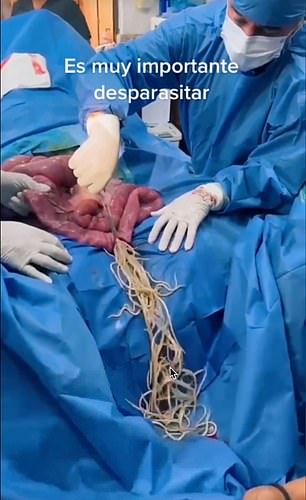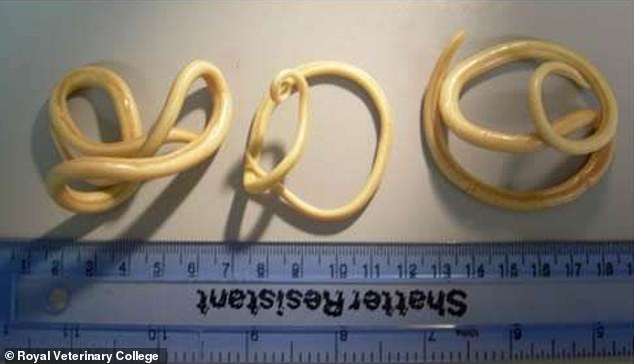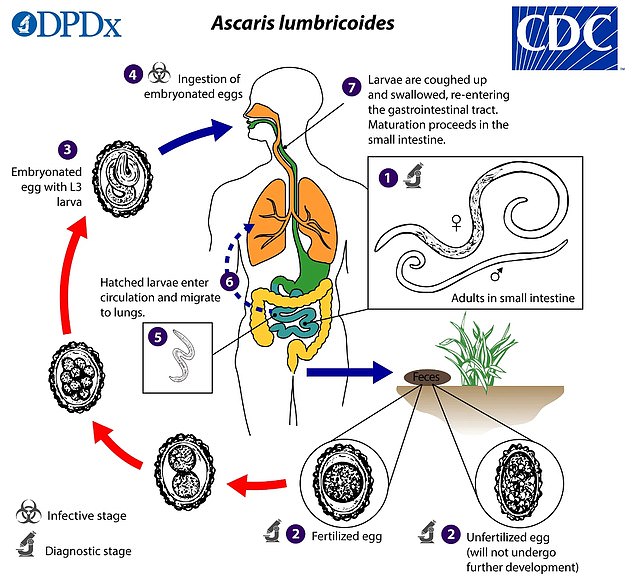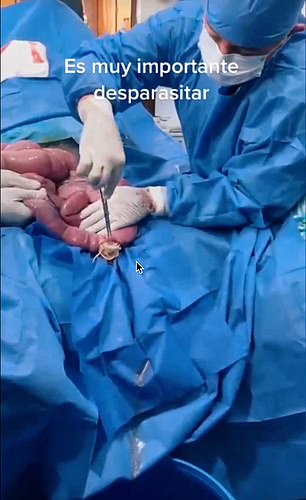An emergency room doctor has shared a graphic and disturbing video to warn Americans about a parasitic infection affecting four million Americans.
The clip, posted by Florida-based physician Dr Sam Ghali, shows a disgusting array of maggots emerging from an intensive care unit onto an operating table.
He explained that the parasites are giant roundworms, or Ascaris lumbricoides, that can grow up to 11 inches long and live in the intestines of humans or animals for up to two years.
Worms, which can be contracted through contaminated food and water, usually cause no symptoms, but large numbers can cause gastrointestinal problems such as abdominal pain, diarrhea and nausea.

Above are two screenshots from the video, which purportedly showed a horse with an intestinal obstruction having its intestines cut open before the worms were removed.
Dr Ghali explains that the video, which has received half a million views on X, actually shows a horse’s intestine; however, he says the worms can also infect humans.
Dr. Ghali explains that, just as in humans, the buildup of worms can lead to a potentially life-threatening intestinal blockage.
However, veterinarians who commented on the video said a human would not normally have such a severe infection.
It is estimated that there are up to one billion people worldwide with giant roundworms, or one in eight, including four million in the United States, or one in every hundred people.
People become infected unknowingly by consuming contaminated food or water containing the worm’s microscopic eggs.
This can occur through contamination of hands with pet feces, and the eggs are then passed onto food while preparing a meal. Water can become contaminated if poor sanitary conditions cause it to mix with feces.

Giant roundworms can grow up to 11 inches (28 cm) long and live in the intestines for one to two years. They only cause symptoms when someone has a heavy infestation.

The CDC graphic above shows the life cycle of the giant roundworm.
Dr Ghali said: ‘While these infestations are not known to actually cause intestinal obstruction in humans, they will obviously cause gastrointestinal symptoms.)
‘This is endemic to places like Mexico and South America, Africa and India.
‘Even if you don’t live there, if you plan to travel to any of those parts of the world, this is definitely something you should know.’
In the United States, infections can occur in rural areas or areas with poor sanitation conditions.
Previously, they have also been linked to close contact with pig farms, which can harbor the worms.
It was unclear when or where the video was filmed, but it is likely from a Spanish-speaking country.
Responding to the clip, one viewer wrote: “Gross! But it’s important to know,” while another said: “I’m about to cancel my trip to Brazil.”
Worm infections are usually diagnosed by looking for traces of microscopic eggs or worms in the stool.
Doctors may also use a colonoscopy, where a camera is placed into the intestine to check for worms.
The infection is treated with antiparasitic medications to kill the worms.
The CDC says online: “This infection is generally rare or nonexistent in developed countries, but sporadic cases may occur in rural and impoverished regions of these countries.”
Once someone consumes roundworm eggs, they hatch in the intestines before the larvae migrate to the bloodstream and lungs.
They grow in these organs before being coughed up and swallowed, allowing the worms to return to the intestines where they live for a year or two.


